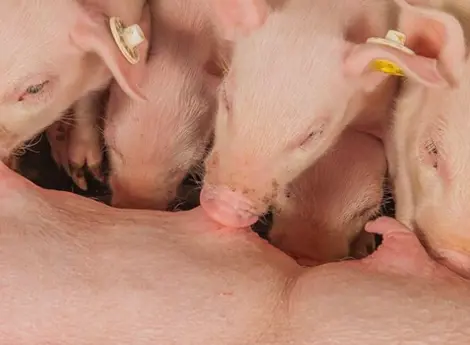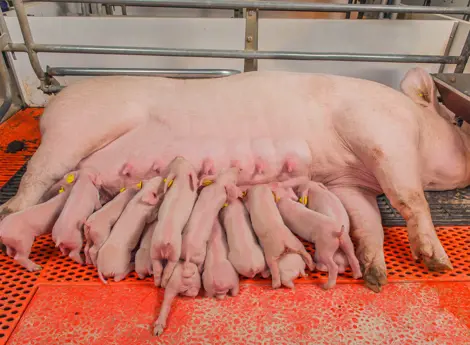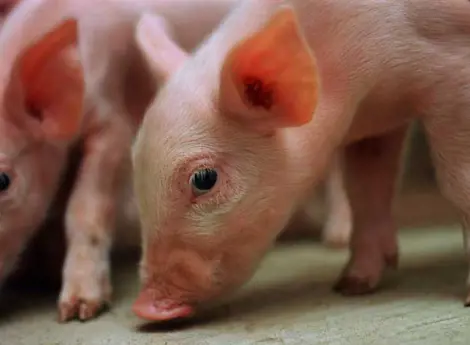Sow feeding in early gestation
The gestation period seems like an easy management period in the reproductive cycle of a sow, and it is often forgotten that a lot is happening during this phase. Gilts are still growing; putting on weight, their udder must develop, and they are pregnant for the first time. Older sows must recover the body losses from the previous lactation and provide nutrients for the development of the next litter. On top of this, she is expected to be in an optimal condition for the next farrowing, produce enough colostrum and give birth to good quality piglets. To achieve these goals, nutrition and feed management must meet the requirements of the sows. This article gives you an insight in sow body development in early gestation.

Requirements for body development
The nutritional requirements of gestating sows are determined by the requirements for maintenance, maternal growth, litter growth and udder development (Figure 1).
 Figure 1. Schematic representation of requirements of sows during gestation.
Figure 1. Schematic representation of requirements of sows during gestation.
Maintenance requirements do not vary much during gestation, and are dependent on body size (weight), ambient temperature and housing conditions (group housed or in crates). Maternal growth has two components; growth to reach mature body weight and growth to recover body condition after the previous lactation (Figure 2). The requirements for litter growth increase as gestation progresses and udder development requirements increase in the third trimester of gestation, from day 85 onwards (Figure 2).

Figure 2. Schematic representation of nutritional requirements for maternal growth and piglet and udder growth.
Maternal Growth and recovery from previous lactation
The main components of maternal growth of a sow that has reached sexual maturity are protein, fat, and water with bone and organ development being much lower. Mature body weight is finally reached by the 4th to 5th parity and during the gestation periods, growth is slower.
During lactation, the sow will often lose body weight due to the demands that are placed on her by the suckling piglets. These losses must be recovered within the first 35-45 days of gestation before the nutrient demand of the developing piglets and udder development increase. It is important to restore body condition as a negative energy balance can increase the risk of abortion.
The amount of nutrients a sow needs to recover will depend on the body condition losses during lactation as well as body condition at weaning. Body condition losses, mainly protein (muscle) and fat (back fat) losses, can be assessed by weighing the sow and measuring the back fat thickness. But how much should be fed to compensate for the weight and back fat losses?
Example calculations
From farrowing to weaning, the sow will lose body weight. At farrowing she will lose the weight of the farrowed piglets as well as the weight of the fluids & placenta. On average, this is around 25kg. She will then usually lose some of her own body weight as protein and fat due to producing milk for the piglets. This body weight loss during lactation is not consistent and will be dependent on several factors:
- Sow body condition at farrowing
- Number of piglets weaned
- Nutrient content of the feed
- Amount of feed consumed
The feed allocation in early gestation will depend upon the desired weight and back fat gain that needs to be achieved. Using a model developed by De Heus, it can be calculated that an intake of 20,870 kcal net energy (NE) will be required to recover a loss of 10 kg in body weight. The amount of feed that must be fed to the sow to achieve this recovery will depend on the energy content of the feed. With a feed containing 2,100 kcal NE/kg about 10kg of feed will have to be fed to recover the lost weight.
Using the same model, it can be calculated that to recover the loss of 2mm of back fat, an intake of 32,012 kcal NE will be required and that 15kg of feed containing 2,100kcal NE would be required to be fed to achieve the required energy intake. However, if there was a loss in both body weight and in backfat thickness, then the requirements for energy are additive, almost. To recover both back fat and muscle, there are some common physiological processes meaning that there is some ‘overlap’ in the requirements making the total requirement not quite the sum of both. Taking this into account, the total requirement would be about 48 000 kcal NE or 23kg of a 2,100kcal diet.
The table below shows how much extra of a 2,100 kcal NE feed would need to be fed to meet the energy requirements to compensate for the maternal weight and/or backfat loss. The same calculations can be done based on the lysine requirements of the sow.

Table 1. Kilograms of extra feed, containing 2,100 kcal NE, that should be fed to compensate for a certain body weight and backfat loss.
Recovery should take place in the first 35-45 days of gestation. The calculated amount of extra feed required to achieve this must be fed during this period. In Figure 3 below is an example of the feeding curves based on different body weight and backfat losses during lactation. A sow that loses 30 kg body weight and 4 mm of backfat will require about 800g more feed per day to recover in the first 42 days of gestation than one that loses 10 kg body weight and 2 mm of backfat.
The increase in the amount of feed at the end of gestation is mainly required for the protein growth of the piglets and to prevent sows using their own body reserves. How big this increase should be will depend on the sows body condition and the number of piglets she is carrying.

Figure 3. Example of feeding schedules for 3rd parity sows with two different maternal body weight and backfat losses in lactation being fed a diet contain 2,100 kcal NE.
Conclusion
By measuring the body condition of your sows, it is possible to make informed decisions on the optimal feeding strategy for sows on your farm. Choosing the right feed and feed allowance optimizes sow body development and litter quality, which is very important for the highly productive sow. Our specialists can help you to define the requirements of your sows and advise on the right feed and feeding schedule.
Disclaimer
Please note that calculations used in this article are model based calculations and some assumptions were used for an ‘on-farm’ situation. They are purely used as an illustration of the effects of weight and back fat losses on the energy requirements of sows. The exact figures may be different for your farm.
Should you require more information relating to Sow feeding in early gestation please contact your De Heus Technical Specialist - https://www.deheus.co.za/meet-our-team/




